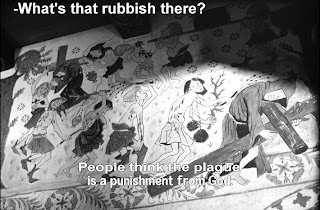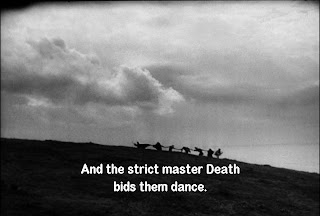Since I found the dvd of this Ingmar Bergman film at my local library the other day while browsing, I thought it would make a nice break from the princess-y movies I've discussed lately to talk a little bit about one of my favorite films of all time: The Seventh Seal (in Swedish: Sjunde Inseglet), starring Max von Sydow of later Exorcist fame. Seventh Seal is considered one of the masterpieces of modern cinema. Premiering in 1957 in Sweden and quickly rising to popularity across global cinema, the scenes of this extraordinary tale blend Medieval allegory with modern existentialist dilemmas about faith, life, and more importantly, death. Indeed, Death is himself personified in the film and is one of the main characters. Similar to Faust, this is a perfect film for those interested in Gothic and allegorical motifs, but if you are a lover of film in general, I would urge you to see this movie. It is a triumph.
Note: Some images taken from this fan site for the film.
More...
Because of the vast amount of critical material regarding this film, I'm only going to briefly synopsize and save you the elaborate commentary: The story follows Antonius Block, a knight who decides to try and cheat Death by playing him in a chess game for his life. Block does not fear Death, but he wants to know whether or not there is something after, if the Paradise promised him for his Crusades is real or not. Traveling with him is his more worldly squire, Jöns, whose way of getting around the death surrounding them (the story is set during the middle of the Bubonic Plague) seems to be through hedonistic pleasures (drinking, brawling and women). Along their travels they encounter a troupe of Medieval players (a manager, an actor and actress, and the latter two's young son), and Jöns "rescues" a young maiden from certain peril (I put the "rescue" in parentheses due to the fact that he acts quite like he owns her afterward--more happy in his vengeance against her attacker--an old rival--than in her newfound safety). Images of life and abundance--visions of the Holy Mother, theatre and merriment, sex and leisure--are constantly being juxtaposed with the bleak reality of ever-present death. His figure appears literally, in Medieval artwork, in the faces of those killed by the plague, and in the horrifying pageantry of the Flagellants (a fanatical religious movement whose members would whip and torture themselves in contrition, seeing the plague as punishment from God):
I won't give away anymore about the film or the characters since I'd like you all to go and see it for yourselves, but I will discuss the history of the famous motif--the Dance of Death--used in the Seventh Seal. The film has made this motif and that of the knight playing chess with Death well-known (so much so that Bill and Ted engage in the same chess game in their Bogus Journey). The Dance of Death in Medieval art depicted a personified Death leading a troupe of dancers from all ages and walks of life (a king, a monk, a peasant, a child, etc.), symbolizing Death's ultimate power to end any person's life at any time regardless of their youth, wealth or spirituality. This certainly fits well with modern existentialist views of the irrational man and chaos that Bergman explores throughout the film. Here is the Dance of Death in the film and its Medieval counterpart, a nice juxtaposition of modern and antique media:
Former: Dance of Death in The Seventh Seal, Latter: Dance of Death from a Medieval cathedral in Tallin, Estonia.
Hope you enjoyed this little homage to a modern classic, and if you like this film I recommend seeing some of Bergman's other works (I ADORE his Magic Flute, as one suggestion).
tata,
beatrix
beatrix










0 comments/comment?:
Post a Comment